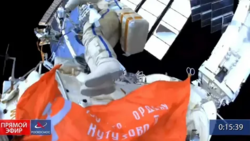International Space Station
 From Conservapedia - Reading time: 2 min
From Conservapedia - Reading time: 2 min

The International Space Station (or ISS) is an artificial satellite orbiting Earth, with the capabilities of supporting human life, and conducting research. Construction of the station began in the 1990s, and the first modules were launched in 1998.[1] The ISS is still in construction today, having been delayed by the Space Shuttle Columbia disaster. The station is jointly managed by NASA, the Russian Space Agency, and the European Space Agency.
The Station is made of several components including habitation, research and service facilities.
Contents
Technical Problems[edit]
As one of the most complex engineering projects in history, the station was planned over several decades and is being constructed over the many countries on earth, the station has experienced various problems. Some of the latest have been retracting a solar panel, spilled food, and a central computer failure. Most of these have been successfully resolved.
Emergency Vehicles[edit]
The International Space Station is equipped with a Soyuz Space vehicle, should it be necessary for the crew to return to Earth during a life-threatening situation.[2]
As the Soyuz spacecraft is only capable of holding a crew of 3, a new "Crew Return Vehicle" is in development. The Crew Return Vehicle or X-38 will be capable of holding a crew of 7, returning to earth within 2–3 hours. The battery system is being designed to hold a charge for up to 9 hours, which would be sufficient for the circumstances in which the craft would be used. The navigation system is designed to be capable of being fully controlled from earth, should the crew be incapable of running the craft.[3]
Waste Management[edit]
It has been reported that NASA paid $19,000,000 for a Russian built human waste management system for the International Space Station. The system is very similar to the existing one, however this new system is designed to be able to deliver waste to the water purification system. According to NASA, purchasing the system is cheaper than building their own. The system is expected to be delivered in 2009.[4]
Final Shuttle Module[edit]
The next and final U.S. module at the International Space Station has been named Tranquility.[5]
 KSF
KSF